Contents
Prune a young apple tree in the spring for beginners is not so difficult. The main condition is to correctly determine the timing and outline the scheme. Shearing is carried out at all stages of growth – from annual seedlings to old trees.
Do I need to prune young apple trees in spring
Pruning an apple tree in the spring should be done annually for several reasons:
- Removing weak branches that take away nutrients but do not bear fruit.
- Removal of old shoots for rejuvenation.
- Thinning the crown for access of air and light to all shoots.
- Stimulating the growth of new branches, which will increase productivity.
- Thinning for easy access to different parts of the crown.
When are apple trees pruned in spring?
It is necessary to prune young apple trees in spring in March, when the air temperature is consistently above 5 degrees. If the temperature is unstable, you need to wait a little longer so as not to disturb the trees. When it’s too cold outside, the wounds on the apple trees don’t heal well, and such pruning will do more harm than good.
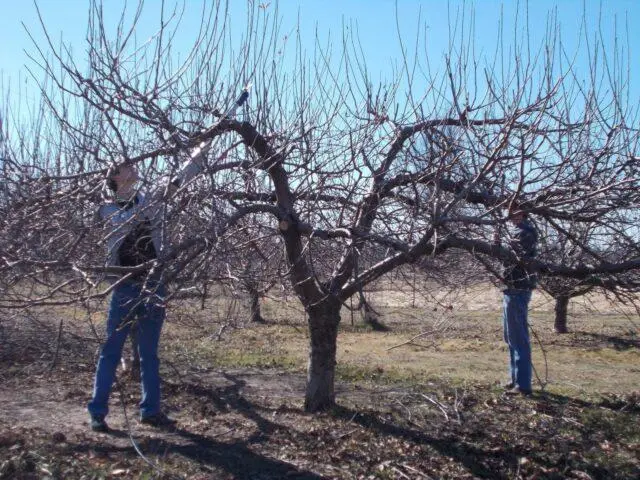
Pruning begins at the very beginning of spring.
It is also impossible to plan work for April and May. At this time, the buds swell, sap flow begins, after which the leaves bloom. Therefore, it is definitely impossible to do pruning at a later date – the wounds will ooze, and the tree may even die.
When choosing dates, it is important to take into account the climatic features of the region:
- the middle band is the first half of March;
- southern regions – middle, second half of February;
- Ural, Siberia, Far East – middle, second half of March.
If in the spring the pruning deadline for the apple tree is missed, you can start work no earlier than October-November. An alternative option is to wait until next season and cut the tree in March.
Types of trimming
There are many types of pruning. Depending on the purpose of pruning, there are several varieties of it:
- Sanitary.
- Formative.
- Anti-aging.
Sanitary pruning of apple trees is carried out every spring. It is necessary in order to remove broken, dry branches, as well as shoots that have been badly affected by frost, diseases or pests.
The formation of the crown of the apple tree is also carried out in the spring, this is especially important in young apple trees. To do this, pinch green growths, thin out branches, shorten shoots by a third of the length or less, remove branches that go far beyond the general contour (for example, side shoots of columnar apple trees).
A rejuvenating haircut is done for old trees over the age of 20 years. To do this, it is necessary to remove old branches that do not bear fruit or give a small harvest. Moreover, it is carried out gradually, annually removing one skeletal branch and several branches of 2-3 orders. At the same time, it is advisable to start pruning not in spring, but in late autumn. The sequence of actions is as follows:
- First, dry and damaged branches are pruned.
- After that, in the spring they make a shaping haircut according to the chosen scheme. At the same time, branches that grow inward are removed.
- The top is removed at a height of 3 m to open the crown of the apple tree.
- The following spring, the rejuvenation procedure is continued, 1-2 skeletal branches are removed, which interfere with the growth of relatively young, well-bearing shoots.
- The same is true for subsequent years.
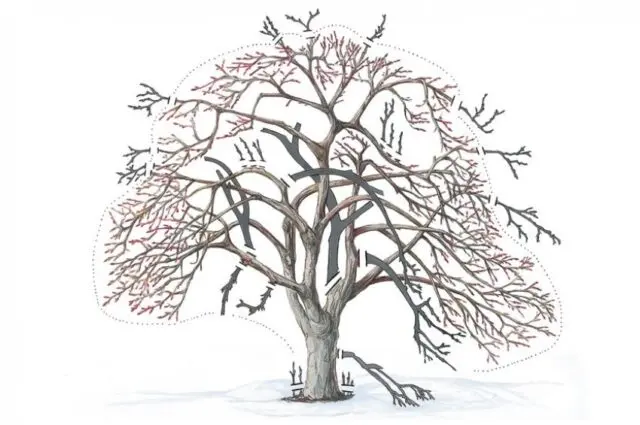
Rejuvenating pruning in the spring of an old tree is aimed at removing broken and thickening branches.
Another classification is based on the intensity with which the haircut is done:
- Weak – pinching annual green shoots to stimulate the growth of other branches, shortening skeletal branches by a quarter of the length.
- Medium – most branches are cut by a third. Such pruning in the spring is carried out for apple trees that are five years old.
- Strong – radical removal of several branches at once. It is carried out for the rejuvenation of adult apple trees (from 10 years old) both in spring and autumn.
You can also distinguish two main ways of cutting:
- Shortening – partial removal of shoots that have grown over the current or last year. This is the most common technique to stimulate the growth of other branches of the apple tree in the spring.
- Thinning is the complete removal of individual branches that interfere with the flow of light to the underlying shoots. Promotes further growth not only in height, but also in width.
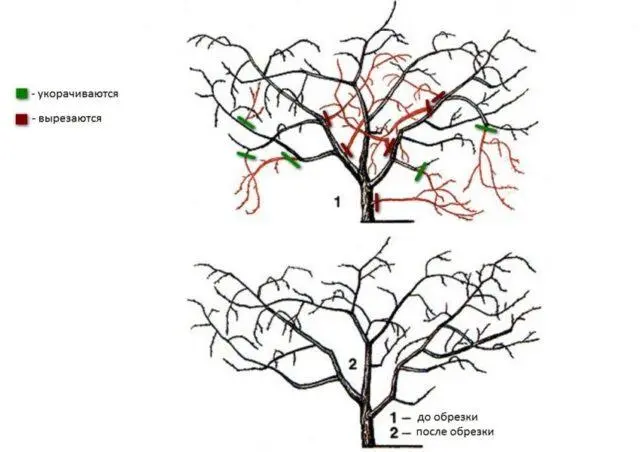
Visual comparison of shortening and thinning
Preparation of tools
To properly prune a young apple tree in spring, you need to choose a scheme and prepare tools. Typically, the following equipment is used for work:
- pruner;
- garden knife;
- delimber with rods of different lengths (required for cutting hard-to-reach shoots);
- saw with a special bend and narrowing towards the end of the blade.
Before starting pruning in the spring, the tools must be sharpened well. If necessary, the blades are washed – they should be free of dirt and rust. Immediately before work, they are disinfected in a dark pink solution of potassium permanganate, vitriol or other antiseptics.
Basic pruning techniques
There are two main pruning techniques – on the ring and on the kidney. In the first case, the branch is deleted completely. To do this, you need to find a zone of an annular growth at the base of the shoot. The cut is made even and clean so that one half of the ring remains on the branch, and the other on the base.
Moreover, you should not leave a stump, otherwise it will dry out, then part of the wood will fall out, and the result will be a hollow. If you cut off the ring completely, go deep into the underlying tissues (cambium), this will lead to severe injury to the apple tree.
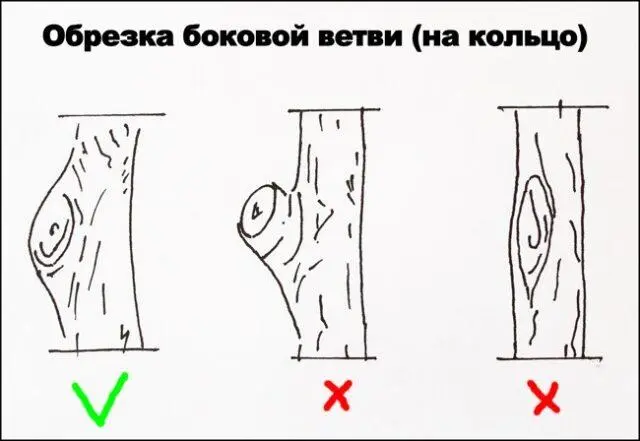
Scheme of correct trimming on the ring
In the second case, the branch is removed partially. Pruning is done on the outer kidney to expand the crown with its further thinning. A cut of a kidney is also allowed, which “looks” inside the crown. They do this to stimulate growth, as well as to compact the crown.

Scheme of correct pruning on the kidney
How to prune young apple trees in spring
Pruning schemes for a young apple tree in spring depend on the purpose for which the procedure is carried out, as well as on the age of the seedling. Shearing is carried out regularly – both for young trees and for old ones. Moreover, it is worth starting to work with annual plants.
Annual seedlings
Pruning of annual seedlings is planned for spring. It is important to start forming a crown from the first year. Thanks to this, all shoots will grow correctly, no need to put supports. It will be convenient to care for trees and harvest.
To make the right haircut, you need to form several tiers with a sparse crown. The sequence of actions is as follows:
- Branches are removed from the central trunk to form a trunk at a height of 1 m. Over the next season, new skeletal branches will form from the buds.
- If the seedling already has shoots, they are cut so that 3-5 buds remain (up to 40 cm long).
- Shoots that grow at an angle of no more than 45 degrees with respect to the central trunk are removed. If they grow at an acute angle, they can break from a strong wind and damage the trunk itself. Also, such branches fall due to a bountiful harvest.
- Several skeletal branches are outlined with a normal angle relative to the trunk – the larger it is, the stronger the shoot will be. They also leave shoots that grow almost at a right angle (perpendicular).
Biennial seedlings
Pruning a young two-year-old apple tree seedling in the spring is carried out according to the same rules as for a one-year-old. First you need to inspect the seedling and leave the strongest shoots that have grown well over the previous season. Moreover, to form a crown, it is enough to outline 3-5 branches. They will form the basis (skeleton) of the tree. The basic rules for pruning are:
- In priority are shoots that grow at an angle of 60-90 degrees with respect to the central trunk.
- To form a longline crown, the lower shoots are shortened less, and the upper ones, on the contrary, more. They should stay up to 30 cm long.
- The conductor (central trunk) should be 30 cm above all other branches, which corresponds to 4-5 buds.
- If the top of the central trunk bifurcates, the weaker branch must be removed. Also, with the help of stretch marks, it can be converted into a skeletal one, as shown in the diagram.
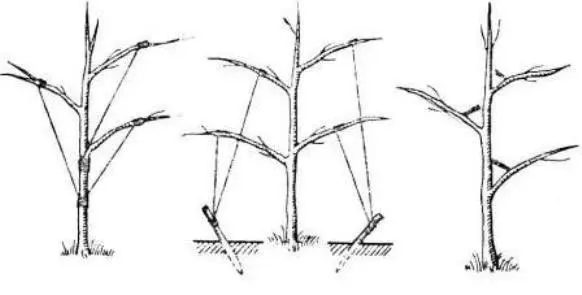
Stretching with ropes allows you to ensure the growth of skeletal branches at an acceptable angle
Young trees (3-5 years old)
In young trees, the crown is already mostly formed. It should have rounded outlines – all strongly protruding shoots should be removed. Pruning is carried out to a minimum, observing the following rules:
- Every spring, all shoots affected by frost are removed.
- Do not allow bifurcation of the trunk – there should be only one central conductor.
- The height of the trunk should be at the level of the branches of the second tier.
- If the side shoots grow rapidly in breadth, they are shortened to the general borders of the crown.
- During work, be sure to leave fruit branches, rings, rings and others. They will bear the first fruits and continue to bear fruit over the coming years.
You can learn how to prune young apple trees in spring from the video.
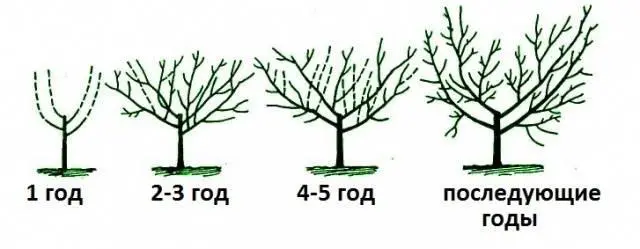
The formation of the crown of an apple tree is carried out in accordance with age
How to prune an adult apple tree
When pruning mature trees, care must be taken to ensure that the trees do not grow too fast. If growth is at a faster pace, it will have a bad effect on yields. The crown will quickly become thick, which will interfere with the care and collection of fruits.
The basic rules for pruning an adult apple tree in spring are:
- It is necessary to inspect the crown and remove branches that clearly thicken the crown. They prevent the access of light to the underlying shoots.
- For the same reason, duplicate shoots that go too close to each other are removed. Of these, only the strongest branches should be left.
- Remove the vertical growth that appeared in the previous season. It weakens the tree too much and thickens the crown. In addition, many large leaves appear on such growth, which interfere with the access of sunlight.
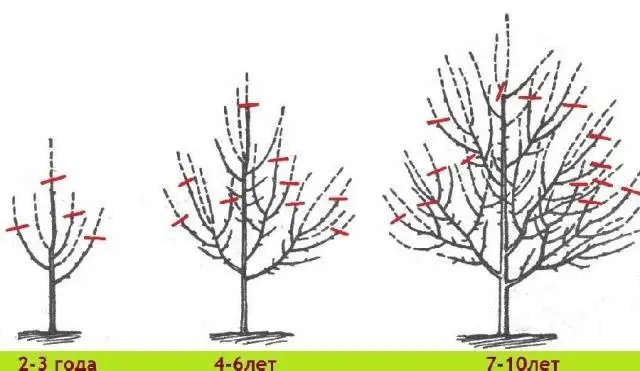
The formation of an adult tree is carried out by year
Care after pruning
Pruning in spring and at other times is always stressful for the culture. Even if you choose the right time, the apple tree may suffer from wounds. To speed up their healing, it is necessary to carry out proper care of the plant.
To do this, it is recommended to carefully weed the near-stem circle and loosen it. In early April, nitrogen fertilization is introduced – granules of urea or ammonium nitrate in the amount of 50 g per 1 m2. They are evenly scattered over the surface, and then watered. It can also be spread over melted snow.
In early spring, after pruning, you do not need to water the apple tree. The soil is still quite wet due to the snow mass, besides, the tree is still “sleeping”. As soon as the temperature becomes positive and the soil dries up, apple trees are given 2-3 buckets per young seedling or 5-8 buckets for an adult tree.
After watering or heavy rain, the soil should be loosened again. To keep the soil moist in spring and summer, mulch is laid on the surface. It can be hay, straw, sawdust, peat and other organic matter.
Wound treatment agents
The basic rule of care after pruning an apple tree in the spring is the treatment of wounds. First of all, they are sprayed with a solution of iron or copper sulfate. A concentration of 3% is sufficient, i.e. 10 g of powder is dissolved in 300 liters of water. Next, coat with garden pitch. You can buy it at the store or make your own.
Other means may also be used:
- a solution of potassium permanganate of a dark pink color;
- Bordeaux liquid;
- cement mortar;
- a mixture of loamy soil with cow cakes.
gardeners mistakes
When pruning an apple tree in the spring, beginners and even experienced gardeners can make mistakes, some of which are quite serious:
- Part of the shoot is removed, leaving too much stump – as a result, a hollow may form through which the infection and pests will penetrate. You need to remove the shoots 2-3 cm above the kidney, making an oblique cut.
- Often summer residents violate the timing of the procedure – they cut too early in February or very late in April.
- They leave a lot of young growth, which thickens the crown.
- Totally remove old branches that still bear fruit normally. Even if they are covered with lichens, mosses, they should be left.
Conclusion
Trimming a young apple tree in the spring for beginners is necessary annually. This is a mandatory procedure that allows you to form a crown, protect the tree from diseases, and also increase productivity. Spring pruning of young apple trees is shown in detail in the video.









